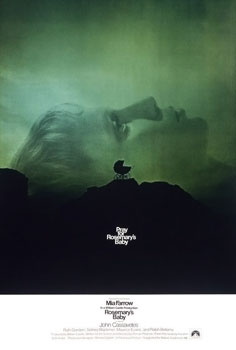“This is no dream! This is really happening!”
— Rosemary Woodhouse (Mia Farrow) in Rosemary’s Baby (1968)
Yes, Rosemary, it is.
The classic 1968 horror movie Rosemary’s Baby is probably best remembered for a lengthy and wonderfully surreal “dream” sequence in which naive newlywed Rosemary Woodhouse (Mia Farrow) is raped by the Devil while a bunch of naked old people stand around her and chant. At one point, she sees her husband, Guy (John Cassavetes), saying that she’s awake and that she knows what’s going on. Their neighbor, Minnie Castevet (Ruth Gordon), tells him that Rosemary can’t hear anything and that it’s like she’s dead and then snaps at him, “Now, sing!” It’s a great sequence, one of the greatest of Roman Polanski’s career, a perfect blending of horror and dark comedy.
For me, the most interesting part of that dream sequence comes at the start. Rosemary envisions herself naked on a boat and, as she tries to cover herself, who is sitting next to her? None other than John F. Kennedy! Suddenly, Rosemary is wearing a bikini and she’s relaxing out on the deck with a glamorous group of people who I assume were meant to be Kennedy relatives. As the boat leaves the dock, Rosemary sees that her friend and protector, Hutch (Maurice Evans), is standing on the dock.
“Isn’t Hutch coming with us?” Rosemary asks.
“Catholics only,” John F. Kennedy hisses in that famous accent, “I’m afraid we are bound by these prejudices.”
“I understand,” a dazed Rosemary replies.
And it’s a wonderful little moment, though I have to wonder if I’d react as strong if my own background wasn’t Irish Catholic. But still, there’s something so wonderfully subversive about a bunch of elderly Satanists pretending to be the Kennedys.
And really, Rosemary’s Baby is a wonderfully subversive film. I imagine it was even more subversive when it was first released back in 1968. It’s been ripped off and imitated so many times that it has undoubtedly lost some of its impact. (That’s one reason why I wish I had a time machine, so I could go back in the past and see it was truly like to see a classic film for the first time.) But still, 47 years after it was initially released, Rosemary’s Baby is still a surprisingly effective horror film.
The film opens with newlyweds Rosemary and Guy moving into the Bramford, an exclusive New York apartment building. Guy is an actor who, despite having appeared in two off-Broadway shows (one of which was entitled Nobody Likes An Albatross and really, that is so true) and a few motorcycle commercials, is still waiting for his big break. There are hints that, before she married Guy, Rosemary had a very active and interesting life (when we briefly meet her old friends, they all seem to be a lot more exciting than boring old Guy) but, when we meet her, Rosemary appears to have happily settled into a life of domesticity.
Life at the Bramford is strange. For one thing, Guy and Rosemary appear to be the only young people living in the entire building. (There is a young woman named Terry but she ends up jumping out of a window.) The Woodhouses befriend elderly Minnie Castevet and her husband, Roman (Sidney Blackmer.) Roman claims to have traveled all over the world and embarrasses the Catholic Rosemary by criticizing the Pope. Minnie, meanwhile, is the noisiest person in the world. Guy makes fun of both of them and, yet, he still decides to spend his free time with Roman.
One day, Guy gets a role that he had previously lost. Why? Because another actor is struck by a sudden case of blindness. Shortly afterward, Rosemary has her “dream.” She wakes up and discovers that her body is covered with red scratches. Guy claims that he had sex with her while she was asleep and promises to cut his fingernails.
Soon, Rosemary is pregnant but the Castevets insist that she use their doctor, the firm and sinister Dr. Saperstein (Ralph Bellamy, who just 8 year earlier had played FDR in Sunrise at Campobello). Rosemary knows that something is wrong with the baby but she can’t get anyone to listen to her. It all leads to one of the best and most iconic endings in the history of horror cinema.
Rosemary’s Baby is a classic of fear and paranoia and it holds up surprisingly well. See it this October, whether you’re Catholic or not.
(However, do not see the needless 2014 remake. Seriously, what the Hell was up with that?)
(By the way, is anyone else amazed that I made it through this entire review without making a single joke about either Ronan Farrow or Mia’s lame Sharknado live tweet? I am shocked.)

